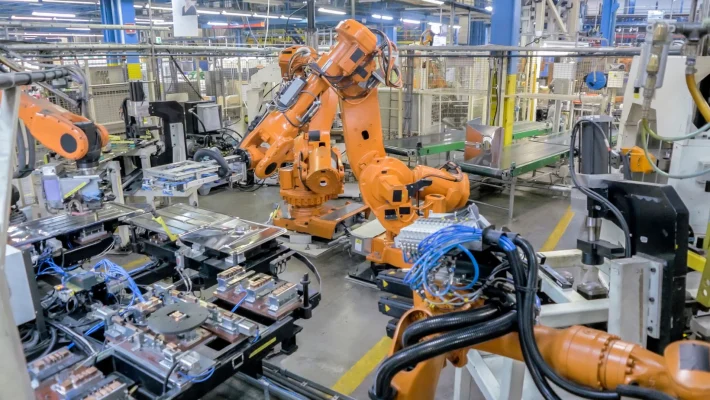Energy Management in Process Manufacturing: A Role for MES
Table of content Understanding Process Manufacturing The Challenge of Energy Management The Role of MES in Energy Management Overcoming Challenges and Implementation Considerations Future Trends and Innovations Conclusion In the dynamic landscape of process manufacturing, optimising energy consumption has become a critical concern. As industries strive to achieve sustainability goals and reduce their environmental footprint, effective energy management has emerged as a key strategy. Manufacturing Execution Systems (MES) play a pivotal role in this endeavour by providing the tools and insights necessary to monitor, control, and optimise energy usage throughout the production process. Understanding Process Manufacturing Process manufacturing involves the conversion of raw materials into finished products through a series of chemical, physical, or biological transformations. Industries such as chemicals, pharmaceuticals, food and beverage, and oil and gas are prominent examples. Unlike discrete manufacturing, where individual units are produced separately, process manufacturing involves continuous or batch production methods. In these complex operations, energy-intensive processes are integral to the production cycle. Heat, electricity, and other forms of energy are crucial inputs, and their efficient utilisation directly impacts production costs, product quality, and environmental sustainability. The Challenge of Energy Management The challenge in process manufacturing lies in striking the right balance between production efficiency and energy consumption. Often, plants face difficulties in identifying energy wastage, understanding consumption patterns, and implementing effective measures to optimise energy usage. This is where MES steps in as a powerful ally. The Role of MES in Energy Management Real-Time Monitoring and Data Acquisition MES platforms enable real-time monitoring of various production parameters, including energy consumption. By integrating with sensors and control systems, MES captures data on equipment performance, production rates, and energy usage. This real-time visibility empowers plant managers to identify inefficiencies, detect anomalies, and take corrective actions promptly. Historical Data Analysis Beyond real-time monitoring, MES facilitates the analysis of historical data. By examining trends and patterns in energy consumption over time, manufacturers can gain valuable insights into the factors influencing efficiency. This historical perspective is crucial for identifying long-term trends, setting benchmarks, and formulating strategies for continuous improvement. Energy Performance Metrics MES provides a comprehensive set of energy performance metrics that serve as Key Performance Indicators (KPIs) for evaluating the efficiency of energy usage. These metrics may include energy intensity per unit of production, Overall Equipment Effectiveness (OEE) from an energy perspective, and energy cost per unit. By tracking these metrics, manufacturers can assess their energy performance, compare it against industry benchmarks, and prioritise areas for improvement. Integration with Control Systems MES seamlessly integrates with control systems, allowing for a holistic approach to energy management. By interfacing with Programmable Logic Controllers (PLCs) and Distributed Control Systems (DCS), MES can dynamically adjust production parameters based on real-time energy data. This integration ensures that energy-saving measures are implemented in response to changing production conditions, maintaining the delicate balance between efficiency and output. Demand Response and Peak Load Management Process manufacturing often involves dealing with fluctuating energy prices and demand variations. MES enables proactive energy management strategies such as demand response and peak load management. By analysing historical data and market trends, MES can help plants schedule energy-intensive processes during periods of lower demand or when energy prices are more favourable, resulting in cost savings and reduced environmental impact. Overcoming Challenges and Implementation Considerations While the benefits of MES in energy management are evident, successful implementation requires careful consideration of various factors: System Integration Integrating MES with existing control systems, sensors, and other data sources is crucial for seamless data flows. Compatibility and interoperability with the plant’s existing infrastructure should be thoroughly assessed to ensure a smooth implementation process. Scalability As manufacturing processes evolve, the MES solution must be scalable to accommodate changes in production volumes, product lines, and energy requirements. A scalable MES can adapt to the dynamic nature of process manufacturing and continue to deliver value over the long term. Employee Training and Change Management The successful adoption of MES for energy management relies on the engagement and understanding of plant personnel. Providing comprehensive training programs and implementing effective change management strategies are essential to ensure that operators, engineers, and managers are aligned with the goals of energy optimisation. Data Security Given the sensitive nature of production data, ensuring the security of information within the MES platform is paramount. Robust cybersecurity measures must be in place to protect against unauthorised access, data breaches, and other potential threats. Regulatory Compliance Industries, especially those in pharmaceuticals and chemicals, are subject to stringent regulatory requirements. The MES solution should support compliance with industry-specific regulations related to data integrity, traceability, and reporting. Future Trends and Innovations As technology continues to advance, the role of MES in energy management is poised to evolve. Several trends and innovations are likely to shape the future of energy optimisation in process manufacturing: Artificial Intelligence and Machine Learning The integration of Artificial Intelligence (AI) and Machine Learning (ML) into MES platforms will enhance the ability to predict, analyse, and optimise energy consumption. These technologies can identify subtle patterns in data, recommend optimal operating conditions, and even predict equipment failures before they occur. Edge Computing Edge computing brings processing power closer to the data source, reducing latency and enabling real-time decision-making. MES solutions leveraging edge computing can provide instantaneous insights into energy usage, allowing for immediate adjustments to optimise efficiency. Digital Twins The concept of digital twins involves creating virtual replicas of physical assets, processes, or systems. In the context of process manufacturing, creating digital twins of production lines can facilitate advanced simulations and scenario analysis for energy optimisation. MES integrated with digital twin technology can offer a powerful tool for experimenting with different energy management strategies in a risk-free virtual environment. Energy Blockchain Blockchain technology, known for its transparency and security, holds the potential for revolutionising energy management. In a blockchain-based system, energy transactions and data sharing can be securely recorded and verified, promoting trust among stakeholders and facilitating the creation of decentralised energy grids. Conclusion Energy management is a critical aspect of achieving sustainability goals and maintaining
Read MoreDiscover How MES Enhances Discrete Manufacturing in the Age of Industry 4.0 and Boosts Productivity
Table of content Introduction How MES Enhances Discrete Manufacturing in the Age of Industry 4.0 MES Implementation Best Practices: Making Integration Smooth Overcoming Challenges in Using MES for Discrete Manufacturing Conclusion Introduction Industry 4.0 reshapes product creation in the manufacturing industry. This guide focuses on Manufacturing Execution Systems (MES) in discrete manufacturing and highlights how MES boosts productivity. Navigate through Industry 4.0 complexities and uncover how MES manages shop floor information to ensure precision and effectiveness. How MES Enhances Discrete Manufacturing in the Age of Industry 4.0 In the world of making things, Manufacturing Execution Systems (MES) are like a guiding force, especially as we step into the era of Industry 4.0. Let’s break down how MES makes a big difference in making things efficient in the modern age. Making Smart Decisions in Real Time MES keeps an eye on everything happening during production. This helps decision-makers have the latest information instantly. Whether it is adjusting schedules, making the best use of machines and people, or dealing with unexpected issues, MES ensures decisions are quick and well-informed. Getting Production Schedules Right MES is like a scheduling wizard. It adjusts production plans on the fly, considering things like machine availability, workforce capacity, and order priorities. This wizardry minimizes downtime and makes sure everything runs smoothly to meet market needs most smartly. Top-Notch Quality Control MES is all about making sure everything that is produced is top-notch. It keeps a close eye on quality at every step, using checks and controls to catch and fix any problems. MES also helps trace each product’s journey through production, making it easier to find and fix quality issues. Keeping Track of Inventory and Supplies MES does not stop at the production line; it also helps with keeping track of materials and supplies. By giving real-time info on inventory, MES makes sure there’s just enough stock, avoiding extra costs and preventing shortages. It also works hand-in-hand with supply chain systems, making sure everything is in sync and ready to meet changes in demand. Getting Along with New Technology MES is like a friend to all the cool new technologies of Industry 4.0, like smart devices and smart analysis. By teaming up with these technologies, MES makes manufacturing not just efficient but also ready for the future. It’s like having a buddy that helps adapt to whatever the digital age throws our way. MES Implementation Best Practices: Making Integration Smooth Bringing Manufacturing Execution Systems (MES) into discrete manufacturing requires thoughtful planning for a successful integration. Let’s explore practical tips and considerations to ensure a smooth implementation of MES into daily operations. Making Systems Work Together Ensure MES fits well with existing systems like ERP and CRM. This integration should flow seamlessly, minimizing disruptions and creating a well-connected digital setup. Training and Helping Employees Adapt Proper training is key. Help the workforce not just understand the new system but use it effectively. Also, manage changes by communicating, providing support, and involving key players in the process. Growing with the Flow Plan for growth. Make MES flexible enough to adapt to changes in production volume, product lines, or new tech. This ensures the system stays useful even as manufacturing needs evolve. Keeping Data Safe With interconnected systems, protect sensitive manufacturing data. Use encryption, access controls, and regular security checks to keep the information secure and instill confidence in users. Thorough Testing Before going live, test MES thoroughly. Simulate different scenarios to catch and fix any issues. This helps avoid disruptions during actual use and builds trust in the reliability of the MES solution. Working Together with Vendors Collaborate closely with MES vendors. Regular communication, quick issue resolution, and ongoing support ensure a smooth journey. Building a strong partnership with the vendor enhances the effectiveness and longevity of the MES solution. Overcoming Challenges in Using MES for Discrete Manufacturing Bringing in Manufacturing Execution Systems (MES) has many advantages for discrete manufacturing, but there are some challenges to tackle. Let’s break down these challenges and find simple solutions to make sure MES works smoothly in the world of making things. Making Different Systems Work Together MES might find it hard to connect with existing systems, causing integration issues. Choose MES that easily fits with different systems. Use middleware if needed, like a helpful bridge connecting MES with other software or machines. This way, information can flow smoothly across all parts of the production process. Getting Everyone Onboard Some workers may not want to use new tech, making it a challenge to get everyone on the same page. Teach everyone how MES helps. Show them how it makes tasks easier, improves work, and makes everything run more smoothly. By giving proper training, everyone can see the benefits and feel positive about using MES. Counting the Costs Getting MES up and running can be costly in the beginning, which might be a concern for some organizations. Look at the bigger picture. MES can save money in the long run by making things more efficient and reducing mistakes. Emphasize these advantages to show how the initial cost is worth it for the benefits it brings. Keeping Information Safe Storing important production data safely is a worry for many, considering data security. Use strong security measures, like keeping data encrypted and controlling who can access it. Follow the rules about data protection and regularly check for any security issues. This builds trust that important information is handled securely. Making MES Fit Just Right Making MES fit exactly with specific manufacturing needs can be tricky. Pick MES that can be adjusted to fit what’s needed. Choose vendors who understand how things work in your making process. This way, MES can be changed without causing problems. Growing Without Problems MES might struggle when operations grow, making it hard to adapt to changes. Choose MES that can grow with the organization. Make sure it can handle more data, more users, and new things to do without slowing down or encountering hiccups. Getting Used to a New Way
Read MoreA Guide to Choosing the Right Vision Based Inspection System
Table of content Introduction What Can Vision Based Inspection Systems Do? Vision Based Inspection Examples Steps to Choose the Right Vision based Inspection System 1. The Inspection System Should be AI Driven 2. Look for Specialization in Your Industry 3. Go Through Customer Reviews 4. Choosing for employee Safety Conclusion Introduction Vision inspection systems harness automated digital imaging to fulfill crucial manufacturing tasks. These tasks encompass steps that require a high degree of precision such as quality control, sorting, and verification. Regarded as indispensable by industrialists today, the technology liberates production line staff for more strategic roles leaving the cumbersome work to the machines. Efficiency of the vision inspection system lies in their high-speed operation, which results in significant time and cost savings for manufacturers. These systems excel in rapid data processing and continually improve through artificial intelligence integration. Furthermore, their capability to generate high-resolution images allows operators to scrutinize product defects with exceptional detail, contributing to less errors in the manufacturing process. In this article, we take a closer look at some of the vision-based inspection solutions and choose one that is right for you. What Can Vision Based Inspection Systems Do? Intelligent inspection systems are often equipped with multiple cameras, along with video and lighting features. These vision systems excel in measuring parts, verifying their correct positioning, recognizing shapes and more. Capable of high-speed measurement and sorting, they employ computer software to process captured images during the assessment process, extracting valuable data. Integration into production lines allows these systems to offer a continuous flow of information, ensuring real-time insights and efficient decision-making for enhanced operational precision. Vision Based Inspection Examples Here are some of the frequently used vision inspection systems in different industries: Steps to Choose the Right Vision based Inspection System While you may already know precisely the vision-based inspection you need for your industry, choosing the system goes well beyond the technology. It is equally important to choose the right partner/vendor who can deliver precisely what you need and ease the process of implementation. So here’s how you arrive at your solution before implementing vision based inspection: 1. The Inspection System Should be AI Driven Legacy systems with simple programming have been the standard since visual-based inspection came into existence. However, AI reinforcement can fundamentally augment detection systems and increase the scope of error detections in production. Visual-based Inspection, powered by deep learning algorithms, elevates the process by enabling the differentiation of parts, characters, and anomalies. This mirrors the capacity of human visual defect detection while leveraging the computational efficiency of a computer system. What’s more, unlike human operators who are subject to fatigue and experience, the AI system performs consistently. 2. Look for Specialization in Your Industry Selecting a vision-based inspection system tailored to your industry can make a significant difference. Opting for a partner specializing in your specific sector is not merely a matter of cost; it is an investment in precision and expertise. Entrusting an experienced partner even if their service may entail a slightly higher cost, outweighs the risks of inexperienced handling. A specialized partner comprehends the intricacies of your industry, foreseeing and addressing impending challenges with well-tailored solutions. The decision to engage an industry-focused expert ensures the perfect integration of vision-based inspection systems, enhancing efficiency and mitigating risks associated with subpar solutions. 3. Go Through Customer Reviews When choosing a partner, go deeper into customer reviews, industry relevance, and challenges faced. Scrutinize project quality, services, timelines, duration, and costs comprehensively to avoid partnering with an unsuitable vendor. Assess their success rates and industry track record, examining their impact on businesses. Analyze their approach and ensure their solutions align precisely with your needs. Explore their client base from past and present to gauge their expertise and the breadth of industries they are able to serve. Additionally, verify if their technology is a good match for your requirements and does not fall short of any future upgrades you have planned. 4. Choosing for Employee Safety When picking vision based systems for employee safety, it is crucial to look for a solution that offers more features than what you need. For instance, the system should incorporate face recognition to detect individuals not adhering to mask or safety gadget guidelines. It should also adeptly identify damaged equipment, such as compromised harnesses, helmets, or other PPE, facilitating prompt alerts and replacements. The system must also monitor adherence to safety protocols like social distancing, machinery standard operating procedures, and plant safety protocols, instantly alerting authorities in case of non-compliance. Conclusion By adopting vision-based inspection systems, industries can harness a powerful system for precision and efficiency in manufacture. The integration of advanced cameras, software, and artificial intelligence not only boosts defect detection but also finds application in end-of-line inspections and part segregation.Now that you know the different types of vision-based systems that exist and how to choose the right tech partner for your process, it is time to take the next step! Get in touch with our team and learn how sensing technology and automation can boost your productivity today!
Read More

